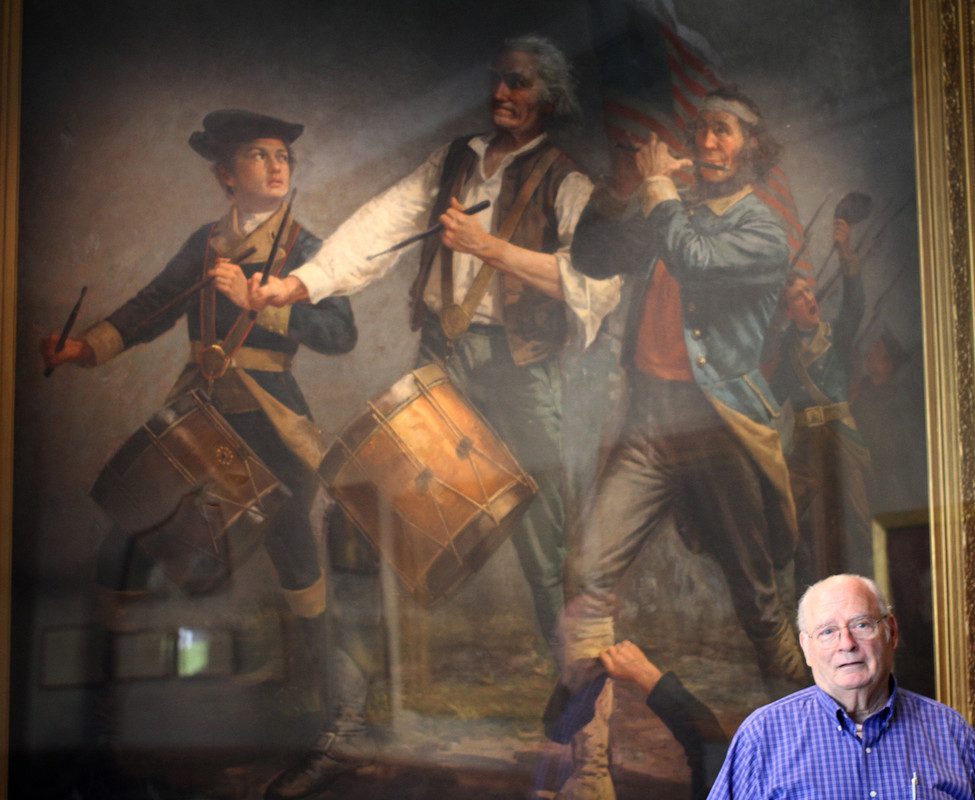MARBLEHEAD — As you walk into the Select Board room inside of Abbot Hall, adjacent to the town clerk’s office, a massive painting fills the back wall, overlooking the table where the five Select Board members and town administrator convene for their meetings.
The painting, encased in a cover for its protection, depicts three musicians marching Continental Army soldiers into battle. On the left, a boy plays the drum while he looks to an older drummer in the middle, looking dead ahead as he marches on. To his right is a fifer, stepping ahead with his left foot while he raises the fife to his mouth to play it.
As the three march and play their instruments, an American flag waves in the back, with soldiers’ bayonets raised to the sky.
The painting is known as “The Spirit of ‘76” and, like the town it belongs to, embodies patriotism.
Town Historian Don Doliber reflected on the historic painting ahead of the 247th anniversary of the Declaration of Independence’s adoption on July 4, 1776.
“If you had to come up with anything that represents Marblehead, outside of saying the lighthouse or Abbot Hall, it would be the ‘Spirit of ‘76,’” Doliber said. “It’s basically the jewel in the crown of Marblehead.”
The painting inside of Abbot Hall, previously known as “Yankee Doodle,” is the original, created by Archibald Willard, of Ohio, though he later made multiple copies. Its origin dates back to 1876, when Willard painted it to appear in an exhibit in Philadelphia for the centennial celebrations of America’s independence.
For centuries, music was used by armies in order to communicate military orders to soldiers in battle. The fife’s high notes and the banging of the drums made it possible for soldiers to hear orders from a great distance, even in the heat of battle.
After its appearance in Philadelphia, it made a national tour, and ended up in Marblehead thanks to Gen. John Devereux, a native of the town living in Ohio at the time. Devereux purchased the painting and donated it to the newly-built Abbot Hall.
Each of the three musicians depicted in the painting were real-life models that Willard chose as he wanted to find people “whose faces would express the courage and determination of the early patriots,” according to the town’s website.
Willard’s father modeled as the central drummer; Devereux’s son, Henry K. Devereux, modeled as the drumming boy; and a farmer-soldier named Hugh Mosher, who was a veteran of the American Civil War, modeled as the fifer.
“Devereux bought it to give to his hometown in honor of the sacrifice of the individuals who fought in the American Revolution,” Doliber said.
He then helped Willard hang it up in Abbot Hall, where it has remained for people who walk into the office to look up in awe at its scale and beauty.
“Everybody who comes to Marblehead to visit will go and look at it,” he said. “And they’re amazed by the size of it. It reflects the spirit of Marblehead and has always reflected the spirit of Marblehead.”
For Doliber, that spirit runs through him as well. He noted that before Abbot Public Library was built, the town’s library used to be where the Select Board meets today. At the time, children would sit in the room to read and play, all with “The Spirit of ‘76” overseeing the room. Doliber was one of those children, and the painting means a great deal to him, as well as the Town of Marblehead.
“I grew up with that painting. To me, it was always a place of quietness, and yet something to concentrate on,” Doliber said. “To me, the first thing you look at is that picture. To me, it means independence, it means freedom.”

